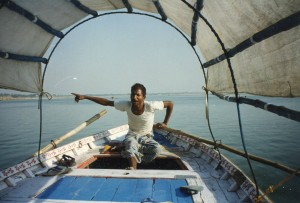“I don’t understand Indian religion. It has too many Gods.” I overheard an elderly British woman say this a year and a half ago in Oxford’s Ashmolean Museum’s section on Indian art. You can’t appreciate the depths of Indian culture through Western mindsets that want everything precisely defined, and in terms of the objects you see in front of your face.
We can overcome the bafflement some Westerners experience by exploring a story about India’s most sacred river, the Ganges.
India’s enormous number of gods, and Hindu cosmology’s unfathomably long temporal cycles can be disorienting for new-comers. These vast panoramic perspectives seem to expand to the farthest reaches of the universe, rather than focus on a distinct character or story. But many things have encouraged this way of thinking about the world. Features of many of India’s most popular stories encourage it too. Myths about the Ganges are good examples.
The Holy Ganges was once a celestial river, sort of like the Milky Way. But on Earth, demons were emerging from the ocean and disturbing hermits’ meditations. The men would chase them back into the water, but the demons kept returning to land on the next day, refreshed and ready for more hard partying.
So the hermits asked a sage named Agastya to help them. He had acquired enormous powers by practicing tapas (austerities), and thus drank up the entire ocean. Though he had noble intentions, this wasn’t a very considerate thing to do in a land that’s as hot as India. All things on earth were deprived of life-giving water. The land became dusty and cracked. People’s and animal’s throats were so dry that they began to choke. Nobody could sanctify their cremated relatives’ ashes. The Holy Ganges flowed up in the sky, but how could it be brought down?
In the next post, we’ll see the solution that Indians imagined, and we’ll discover what this story says about Indian thought and art.


Comments on this entry are closed.